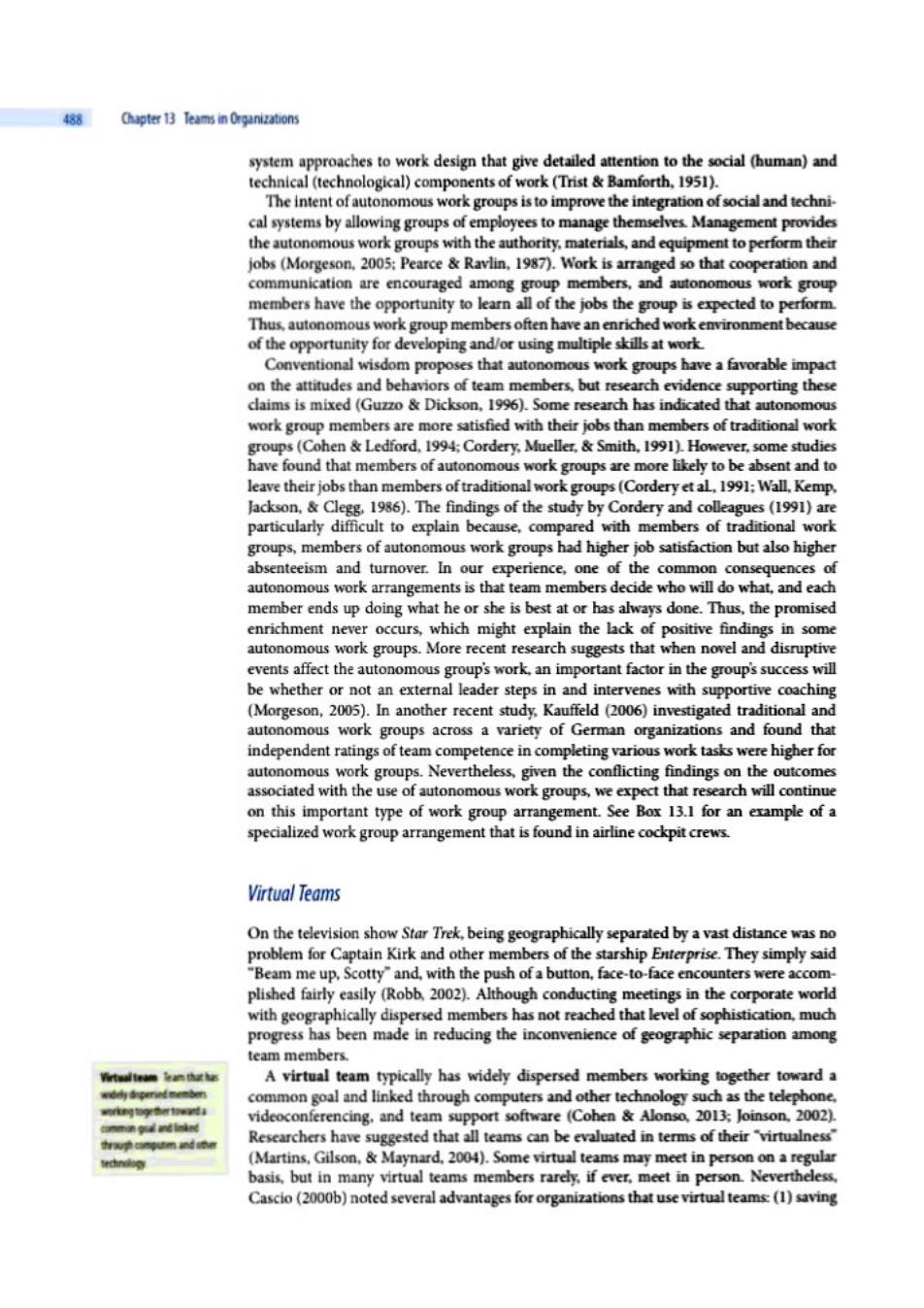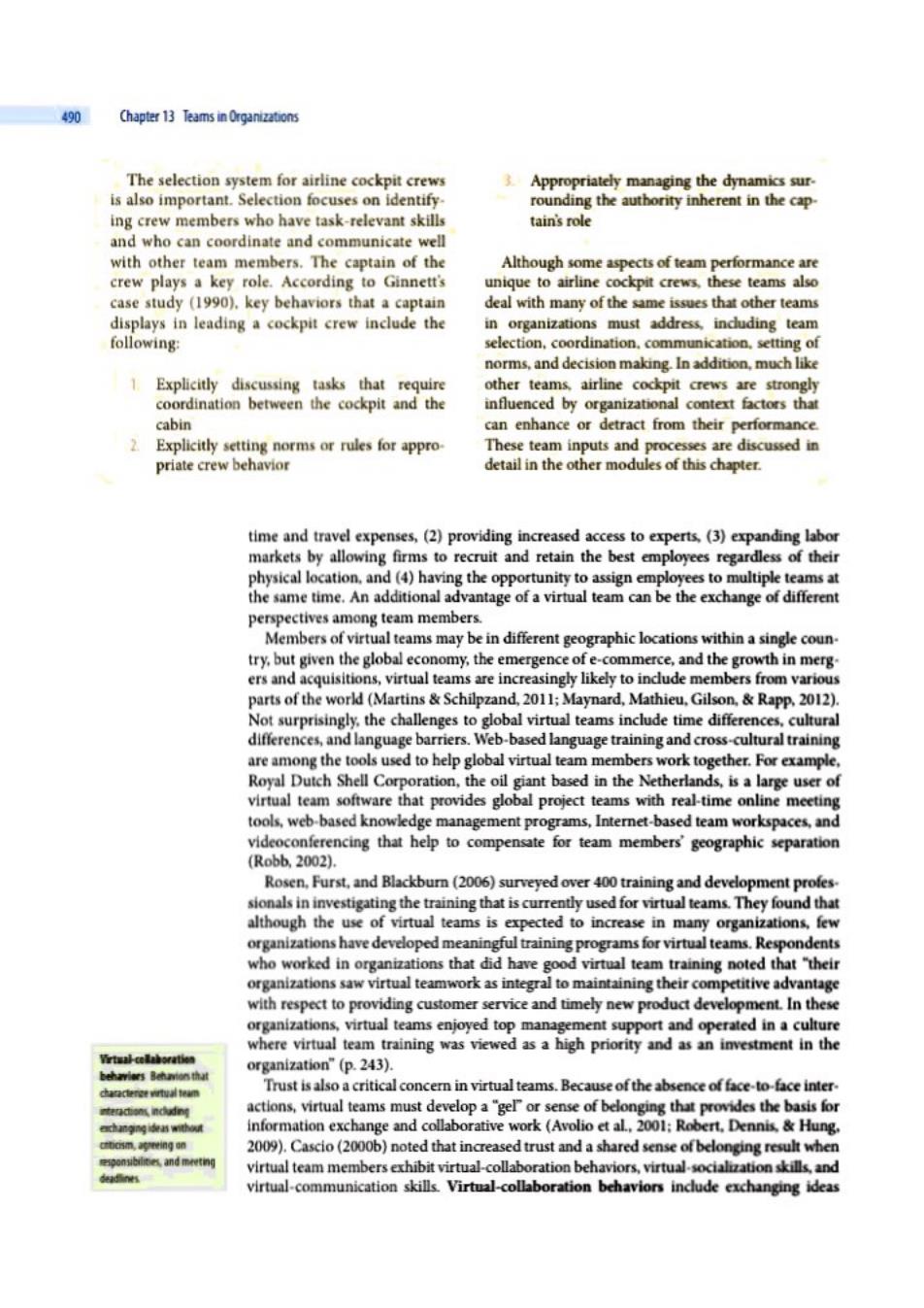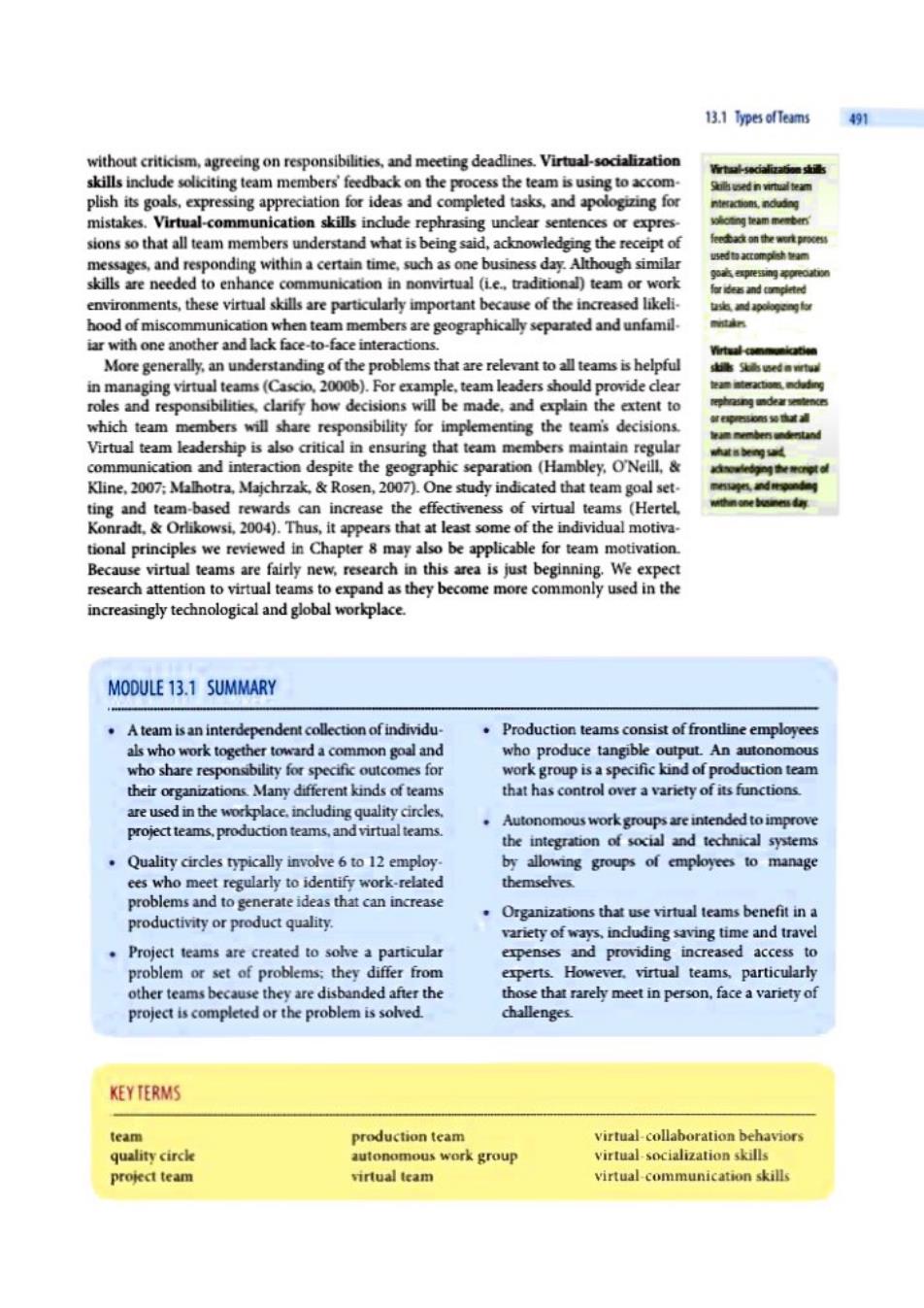
488 Chapter 13 Teams in Organizations system approaches to work design that give detailed attention to the social (human)and technical (technological)components of work(Trist Bamforth.1951). The intent of autonomous work groups is to improve the integration ofsocial and techni- cal systems by allowing groups of employees to manage themselves Management provides the autonomous work groups with the authority.materials,and equipment to perform their jobs (Morgeson,2005;Pearce Ravlin,1987).Work is arranged so that cooperation and communication are encouraged among group members,and autonomous work group members have the opportunity to learn all of the jobs the group is expected to perform. Thus,autonomous work group members often have an enriched work environment because of the opportunity for developing and/or using multiple skills at work. Conventional wisdom proposes that autonomous work groups have a favorable impact on the attitudes and behaviors of team members,but research evidence supporting these claims is mixed (Guzzo Dickson,1996).Some research has indicated that autonomous work group members are more satisfied with their jobs than members of traditional work groups(Cohen Ledford,1994;Cordery,Mueller,Smith,1991).However,some studies have found that members of autonomous work groups are more likely to be absent and to leave their jobs than members oftraditional work groups(Cordery et al,1991:Wall,Kemp. Jackson,Clegg.1986).The findings of the study by Cordery and colleagues (1991)are particularly difficult to explain because,compared with members of traditional work groups,members of autonomous work groups had higher job satisfaction but also higher absenteeism and turnover.In our experience,one of the common consequences of autonomous work arrangements is that team members decide who will do what,and each member ends up doing what he or she is best at or has always done.Thus,the promised enrichment never occurs,which might explain the lack of positive findings in some autonomous work groups.More recent research suggests that when novel and disruptive events affect the autonomous group's work.an important factor in the group's success will be whether or not an external leader steps in and intervenes with supportive coaching (Morgeson,2005).In another recent study.Kauffeld (2006)investigated traditional and autonomous work groups across a variety of German organizations and found that independent ratings of team competence in completing various work tasks were higher for autonomous work groups.Nevertheless,given the conflicting findings on the outcomes associated with the use of autonomous work groups,we expect that research will continue on this important type of work group arrangement.See Box 13.1 for an example of a specialized work group arrangement that is found in airline cockpit crews. Virtual Teams On the television show Star Trek,being geographically separated by a vast distance was no problem for Captain Kirk and other members of the starship Enterprise.They simply said "Beam me up,Scotty"and,with the push of a button,face-to-face encounters were accom- plished fairly easily (Robb,2002).Although conducting meetings in the corporate world with geographically dispersed members has not reached that level of sophistication,much progress has been made in reducing the inconvenience of geographic separation among team members. A virtual team typically has widely dispersed members working together toward a common goal and linked through computers and other technology such as the telephone. videoconferencing.and team support software (Cohen Alonso,2013:Joinson.2002). Researchers have suggested that all teams can be evaluated in terms of their virtualness" (Martins,Gilson,Maynard,2004).Some virtual teams may meet in person on a regular basis.but in many virtual teams members rarely,if ever,meet in person.Nevertheless. Cascio(2000b)noted several advantages for organizations that use virtual teams:(1)saving

13.1 Types ofTeams 489 BON 13.T A SPECIALIZED TEAMT AIRLINE COCKPIT CREW More than a century after the Wright brothers was crippled by the loss of both engines.By all worked as a team to achieve the first recorded accounts,the five-member crew (two in the cockpit flight(December 17.1903).teamwork in aviation and three in the cabin)performed complex tasks in is still a maior concern (Brannick.Prince.Salas. an integrated manner that resulted in the safe exit 2005:Salas.Burke.Bowers,Wilson.2001). of all 150 passengers and the crew without loss of Airline cockpit crews perform highly interdepen. life or serious injury.Notably.the pilot,Captain dent tasks.some that occur routinely in all flights Chesley"Sully"Sullenberger,has a master's degree and others that may occur only in rare but well- in I-O psychology and is professionally involved in practiced emergency situations (Ginnett.1990). crew resource management research and training. Cockpit crews are unique in that they work According to Ginnett(1990).crews benefit from together for a brief time and must effectively per- an organizational context that provides the follow. form critical tasks soon after the crew is formed. ing components: Newly formed crews are able to perform effectively soon after they meet because crew members Challenging objectives for safety,on-time receive extensive training that precedes their work performance.and fuel efficiency on a particular crew. An educational system that provides train. Airline cockpit crews rarely run into problems. ing and consultation to supplement mem. but the real requirements for effective teamwork bers'task expertise occur when they do.A spectacular example is the An information system that provides the Hudson River landing of US Airways flight 1549 in data needed to assess situations and evaluate lanuary 2009.Moments after take-off,the airplane alternative strategies for handling them When US Ainways flight 1549 had to make an emergency landing in the Hudson River. the crew performed complex tasks in an integrated manner that resulted in the safe exit of all 150 passengers and the crew. (Continued)

490 Chapter 13 Teams in Organizations The selection system for airline cockpit crews Appropriately managing the dynamics sur. is also important.Selection focuses on identify- rounding the authority inherent in the cap. ing crew members who have task-relevant skills tain's role and who can coordinate and communicate well with other team members.The captain of the Although some aspects of team performance are crew plays a key role.According to Ginnett's unique to airline cockpit crews,these teams also case study (1990).key behaviors that a captain deal with many of the same issues that other teams displays in leading a cockpit crew include the in organizations must address,induding team following: selection,coordination.communication.setting of norms,and decision making In addition,much like 1 Explicitly discussing tasks that require other teams.airline cockpit crews are strongly coordination between the cockpit and the influenced by organizational context factors that cabin can enhance or detract from their performance 2 Explicitly setting norms or rules for appro- These team inputs and processes are discussed in priate crew behavior detail in the other modules of this chapter. time and travel expenses,(2)providing increased access to experts.(3)expanding labor markets by allowing firms to recruit and retain the best employees regardless of their physical location.and (4)having the opportunity to assign employees to multiple teams at the same time.An additional advantage of a virtual team can be the exchange of different perspectives among team members. Members of virtual teams may be in different geographic locations within a single coun. try,but given the global economy,the emergence of e-commerce,and the growth in merg ers and acquisitions,virtual teams are increasingly likely to indlude members from various parts of the world (Martins Schilpzand,2011;Maynard,Mathieu,Gilson,Rapp,2012). Not surprisingly,the challenges to global virtual teams include time differences,cultural differences,and language barriers.Web-based language training and cross-cultural training are among the tools used to help global virtual team members work together.For example, Royal Dutch Shell Corporation,the oil giant based in the Netherlands,is a large user of virtual team software that provides global project teams with real-time online meeting tools,web-based knowledge management programs,Internet-based team workspaces,and videoconferencing that help to compensate for team members'geographic separation (Robb.2002). Rosen,Furst,and Blackburn(2006)surveyed over 400 training and development profes. sionals in investigating the training that is currently used for virtual teams.They found that although the use of virtual teams is expected to increase in many organizations,few organizations have developed meaningful training programs for virtual teams.Respondents who worked in organizations that did have good virtual team training noted that "their organizations saw virtual teamwork as integral to maintaining their competitive advantage with respect to providing customer service and timely new product development.In these organizations,virtual teams enjoyed top management support and operated in a culture where virtual team training was viewed as a high priority and as an investment in the Virtsal-celahoration organization"(p.243). Trust is also a critical concern in virtual teams.Because of the absence of face-to-face inter- actions,virtual teams must develop agel or sense of belonging that provides the basis for information exchange and collaborative work (Avolio et al.,2001;Robert,Dennis,Hung. 2009).Cascio(2000b)noted that increased trust and a shared sense ofbelonging result when t线and meetin virtual team members exhibit virtual-collaboration behaviors,virtual-socialization skills,and virtual-communication skills.Virtual-collaboration behaviors include exchanging ideas

13.1 Types ofTeams 491 without criticism,agreeing on responsibilities,and meeting deadlines.Virtual-socialization 指tal-seciafin5e通 skills include soliciting team members'feedback on the process the team is using to accom- Skilk ued n virtual team plish its goals,expressing appreciation for ideas and completed tasks,and apologizing for mistakes.Virtual-communication skills indude rephrasing undear sentences or expres- sions so that all team members understand what is being said,acknowledging the receipt of ee士adk on the wurk pro messages,and responding within a certain time,such as one business day.Although similar skills are needed to enhance communication in nonvirtual (ie..traditional)team or work for ideas and completed environments,these virtual skills are particularly important because of the increased likeli. 如地d娘o国a hood of miscommunication when team members are geographically separated and unfamil. iar with one another and lack face-to-face interactions. rtul cmmlot心ee More generally,an understanding of the problems that are relevant to all teams is helpful 山i Skis ued n wrtua in managing virtual teams(Cascio,2000b).For example.team leaders should provide clear roles and responsibilities,clarify how decisions will be made,and explain the extent to which team members will share responsibility for implementing the team's decisions. Virtual team leadership is also critical in ensuring that team members maintain regular communication and interaction despite the geographic separation (Hambley.O'Neill, Kline,2007:Malhotra,Majchrzak,Rosen,2007).One study indicated that team goal set. ting and team-based rewards can increase the effectiveness of virtual teams(Hertel. Konradt,Orlikowsi,2004).Thus,it appears that at least some of the individual motiva- tional principles we reviewed in Chapter 8 may also be applicable for team motivation. Because virtual teams are fairly new,research in this area is just beginning.We expect research attention to virtual teams to expand as they become more commonly used in the increasingly technological and global workplace. MODULE 13.1 SUMMARY A team is an interdependent collection of individu- Production teams consist of frontline employees als who work together toward a common goal and who produce tangible output.An autonomous who share responsibility for specific outcomes for work group is a specific kind of production team their organizations Many different kinds of teams that has control over a variety of its functions. are used in the workplace.including quality circles. project teams.production teams,and virtual teams. Autonomous work groups are intended to improve the integration of social and technical systems Quality cirdes typically involve 6 to 12 employ. by allowing groups of employees to manage ees who meet regularly to identify work-related themselves problems and to generate ideas that can increase productivity or product quality. .Organizations that use virtual teams benefit in a variety of ways,induding saving time and travel Project teams are created to solve a particular expenses and providing increased access to problem or set of problems:they differ from experts.However.virtual teams.particularly other teams because they are disbanded after the those that rarely meet in person,face a variety of project is completed or the problem is solved. challenges KEY TERMS team production team virtual-collaboration behaviors quality circle autonomous work group virtual-socialization skills project team virtual team virtual-communication skills